Open Government Plan 4.1
PDF version of the Open Government Plan 4.1
Introduction
Welcome to our Open Government Plan 4.1. Last updated on February 17, 2017, this plan reflects our continuing effort to become more transparent to the American public. We also invite greater public participation in the policies and decisions of our agency and foster expanded collaboration with the people we serve. Our stakeholders include advocates and many government and non-government groups.
This plan includes our commitments to improve our operations and services in an open and transparent manner. Our Open Government Plan 4.1 (Section III) includes a flagship initiative, National Disability Forum, and five major initiatives. These efforts will help us carry out long-term strategies embodied in our Vision 2025. We strive to deliver superior customer service, develop exceptional employees, and operate as an innovative organization. We encourage you to read our Vision 2025 and visit the Open Government website to see the information and data available online. We welcome your thoughts on more data and information you want us to make available to the public.
In putting our current plan together, we sought comments from the public, our employees, and advocates. We appreciate your interest and participation, and welcome your additional insight on ways we can improve our programs and service to you.
Follow our Open Government Plan 4.1 - Plan Milestones and Completion Report for progress on the milestones in our plan and share your thoughts and ideas by sending a message to open.government@ssa.gov.
Mission

Our Agency Mission: Deliver Social Security services that meet the changing needs of the public.

Our Open Government Mission: Support the agency's core mission through the principles of transparency, participation, and collaboration.

Who We Are and What We Do: We run two of the nation's largest entitlement programs: the Old Age, Survivors, and Disability Insurance program and the Supplemental Security Income (SSI) program. In addition, we assist people in applying for food stamps and Medicare, including subsidies for the Medicare Prescription Drug Program. For more information on our programs and benefits, read our Understanding the Benefits document. The following chart is a snapshot of how we served America in fiscal year 2015.
| How We Served America in Fiscal Year 2015 | |
|---|---|
| Paid over $930 billion to more than 67 million beneficiaries | Handled approximately 37 million calls on our National 800 Number |
| Served over 40 million visitors in over 1,200 field offices nationwide | Received over 66 million calls to field offices nationwide |
| Completed business with 87 million people through our online services | Completed over 8 million claims for benefits and more than 660,000 hearing dispositions |
| Handled over 35 million changes to beneficiary records | Issued about 16 million new and replacement Social Security cards |
| Posted about 266 million wage reports | Handled over 18,000 cases in Federal District Courts |
| Completed 799,000 full medical Continuing Disability Reviews (CDRs) | Completed over 2.2 million non-medical redeterminations of SSI eligibility |
| Paid over $230 million to vocational rehabilitation and employment support service providers for assisting disabled beneficiaries return to work | |
Section I: Progress on 2014 Open Government Plan 3.0
Examples of accomplishments from the Open Government Plan 3.0 include:
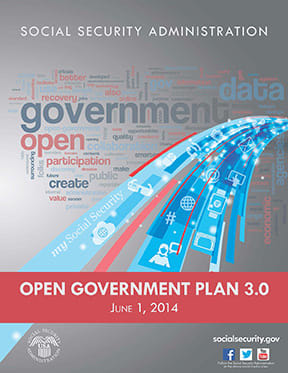
- Total assets in our Public Data Listing are now over 1,500.
- November 2014 — Updated the system of records notice section of our Freedom of Information Act website. The compilation contains a notice of each system of records and related appendices that we maintain. The website now includes the actual Federal Register publication for each of the systems of records.
- February 2015 — Added instant download of tax form SSA-1099 to suite of services available through my Social Security account.
- April 2015 — Issued an open data policy to provide further guidance to the agency.
- April 2015 — Released Vision 2025 webpage, which included a dedicated feedback page with three avenues for engagement: a Survey Monkey survey, an IdeaScale engagement community, and a dedicated Vision 2025 email address.
- April 2015 — Launched Social Security Matters blog, a platform for Social Security to share our goals, programs, and online services with the American public and stakeholders. The blog also provides a forum for readers to share their feedback on various topics.
- June 2015 — Launched an online tool to search through past congressional testimony from 1995 to the present. Testimony is searchable by subject, names, and year.
- August 2015 — Hosted a webinar on iAppeals, providing an overview of the latest iAppeals enhancements. The webinar included a live questions and answers session for advocates, social services agencies, and other third parties.
Accomplishments from our previous plan and progress on all commitments made in our Open Government Plan 3.0 Progress Chart.
Accomplishments of 2012 Open Government Plan 2.0.
Accomplishments of 2010 Open Government Plan 1.0.
Development of Open Government Plan 4.1
The details and commitments laid out in this plan came together with input from the public and agency employees.
We used the crowdsourcing platform IdeaScale to solicit public and employee input for our plan and posted a draft outline. Through our Open Government Plan 4.1 Customer Feedback Process, individuals were able to submit ideas, reply with comments, and vote for preferred ideas. We promoted this open engagement through various outlets, including:
- An e-mail to all Social Security and State Disability Determination Service employees from our Chief Strategic Officer (CSO);
- An agency-wide email and video promoting Sunshine Week activities from our General Counsel and CSO;
- A public post on our official agency blog, Social Security Matters;
- Posts on our official agency Facebook and Twitter accounts;
- A News Item on our official Social Security Open Government portal;
- A Dear Colleague letter sent out to Social Security advocates; and
- A GovDelivery email sent out to individuals who follow our Open Government webpage.
We consulted with our executive leadership on agency priorities and initiatives that promote open government principles. This group included the agency’s Chief Information Officer, Chief Strategic Officer, Chief Financial Officer, Chief Human Capital Officer, General Counsel, and deputy commissioners. We solicited input through our Associate Commissioner-level Open Government Steering Committee that represents all major agency components.
We also participated in the White House Open Government Interagency Working Group’s Civil Society Consultation Fair. Agency open government officials were able to consult with civil society advocates on the contents of the plan. We also invited previous civil society reviewers from the University of Maryland to provide comments through our IdeaScale engagement.
As of this plan’s release, this IdeaScale engagement drew 174 unique visitors, who contributed a total of 38 ideas, 35 comments, and 305 votes. We received ideas ranging from policy changes, to electronic service improvements, to new and innovative outreach strategies. While some of these suggestions are still being analyzed and considered for incorporating into future initiatives, many suggestions are included in our current plans. For example, we received several suggestions for a “Click to Chat” feature for our online services, which is included in our plans. We also received a suggestion for utilizing the social media platform YouTube as an engaging way to reach our customers. While we already have a robust library of webinars and short videos in our YouTube library, we are in the process of producing short, informative animated videos educating the public about important aspects of our programs. The popularity of these ideas in the engagement underscores the importance of focusing on improving customer service in our open government efforts.
Section II: Open Government Goals and Objectives
Goal I: Improve Transparency
Social Security will meet the Open Government principle of transparency through information sharing and accountability
We strive to promote clear, concise, and well-organized writing to communicate effectively with the public and operate more efficiently. The Center for Plain Language evaluates how effectively Federal agencies comply with the Plain Writing Act of 2010. In May 2016, for the third year in a row, our combined grade on the Federal Plain Language Report card is best in class! We received an A+ for Compliance and an A for Writing and Information Design. We also received a ClearMark “Award of Distinction” for our homepage redesign. These grades reflect our strong commitment to clear communication at all levels.
Improving transparency is a multi-faceted effort that includes:
- Expanding and enhancing our public web presence with agency program data and information;
- Providing targeted information for researchers, academics, the press, Congress, and other stakeholders;
- Using social media and other tools more effectively to share information, and engage the public;
- Conducting data exchanges with researchers and other government organizations;
- Identifying and releasing data in an open, accessible, and machine-readable format to the extent that protection of personal information permits sharing that data;
- Complying with Federal Information Technology Acquisition Reform Act (FITARA) requirements to share publicly our IT processes and policies (see our FITARA Common Baseline Implementation Plan on page 19); and
- Providing our employees with innovation methods, training, and tools to access data.
For more information about our involvement in Federal transparency initiatives, see Appendix A.
Objective 1: Support open data principles

We are expanding the information we make publicly available. You can see the growth in our inventory. Access to the SSA assets is available at the following data.gov link.
We outlined implementation of open data principles through several documents that date to the beginning of open government. We published our first open government plan in June 2010, and our first data inventory document in September 2010. We continued to document our progress during the following years through the Digital Government Strategy (DGS). This document contains milestones that addressed our data inventory and publication efforts. Our new Information Resources Management Strategic Plan for Fiscal Years 2016-2019 (page 68) includes updated information about the DGS. The plan incorporates data transparency considerations into the systems development lifecycle.
We continue to provide quarterly reports to the Office of Management and Budget (OMB) about how we are meeting the open data Cross-Agency Priority Goal. We earned a ranking of "green" for the May 2016 quarter assessment period. Since the inception of the open data Cross-Agency Priority Goals, our agency has been “green” for every quarter showing our support of the initiative.
One of our major initiatives is the Analytics Center of Excellence (ACE). ACE provides information about how we will use data to further our core mission while increasing accountability, responsiveness, effectiveness, and efficiency. This effort is in strategic alignment with our Vision 2025 and our critical agency priorities.
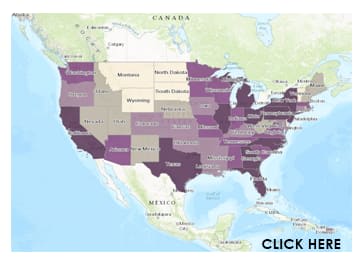 We are always looking for new ways to present data to the public. Recently we began identifying public Social Security data that can be adapted and visualized through geospatial maps and Application Programming Interfaces (API). Our goal is to provide the public with a deeper understanding of our programs through geographic representations and APIs. Examples of the types of maps and APIs we are creating include our research data and data on our public services. We will make these maps and APIs available at ssa.gov, Data.gov, and GeoPlatform.gov, as appropriate. We published our first map in May 2016. It presents basic program data on the benefits paid in each State by age and gender. Plans for future maps include data on public service locations. For more information, or to give us your ideas on data that would benefit from these methods contact us at open.government@ssa.gov or through IdeaScale, which allows everyone to comment and vote on interesting topics.
We are always looking for new ways to present data to the public. Recently we began identifying public Social Security data that can be adapted and visualized through geospatial maps and Application Programming Interfaces (API). Our goal is to provide the public with a deeper understanding of our programs through geographic representations and APIs. Examples of the types of maps and APIs we are creating include our research data and data on our public services. We will make these maps and APIs available at ssa.gov, Data.gov, and GeoPlatform.gov, as appropriate. We published our first map in May 2016. It presents basic program data on the benefits paid in each State by age and gender. Plans for future maps include data on public service locations. For more information, or to give us your ideas on data that would benefit from these methods contact us at open.government@ssa.gov or through IdeaScale, which allows everyone to comment and vote on interesting topics.
Objective 2: Inform the public about significant planned actions supporting transparency (Public Notice)
We use several communication tools and approaches to support transparency, including our Open Government website. We foster the use of agency data through ongoing contacts with stakeholders and interested parties. We discuss our information dissemination methods on pages 64 and 65 of our Information Resources Management Plan.
Objective 3: Provide information the public wants and needs for their lives and businesses
We provide members of the public with information they request either through the Freedom of Information Act (FOIA) process or through other means. This includes outreach with stakeholders and ongoing relationships with advocates, Congress, and other interested parties. In addition, we provide information about our programs and internal management processes at the SSA Homepage and in our annual performance and accountability reports.
We provide information about our internal management processes for information resources and, specifically, our plan for implementing a common baseline for IT processes and policies. Our Capital Planning and Investment Control Process is also available online.
Freedom of Information Act (FOIA)
We operate under a presumption of openness, sharing information with the public about our programs and projects. In fiscal year (FY) 2015, our agency processed 22,922 FOIA requests. Our backlog at the end of the fiscal year was just 146 cases, or 0.64 percent of all FOIA requests received by our agency in FY 2015.
We are currently revamping our FOIA website to update the language, create a more user-friendly request page, and include more items in our FOIA Library. These changes will provide requesters with additional information on the types of records they can directly request from their servicing field offices. These updates will reduce requesters’ wait times for information and allow the FOIA staff to focus on other requests.
We are examining the possible integration of an existing and tested FOIA system to improve the processing of our FOIA workload. We are working with the Environmental Protection Agency on the requirements needed to implement their FOIAonline shared service application for our operations.
FOIAonline is currently in use by 12 Federal agencies. FOIAonline has an established record of accomplishment and demonstrated capabilities. We believe that this system will provide better case management, audit and tracking capabilities for both the Social Security Administration (SSA) and the requester community. We also expect these enhancements to facilitate the electronic delivery of responses and provide accurate management information data for our FOIA Annual Report.
More detailed information about our FOIA program is available at the FOIA Homepage.
Proactive Disclosures
To disclose information proactively, we make a great deal of information available on our FOIA website, component's websites, and Data.gov. Our Open Government portal provides a gateway for much of our public information. We provide proactive disclosure items in our FOIA Library. Proactive disclosure items that we post include frequently requested records, and other FOIA-processed documents, which are likely to be of interest to wider audiences.
Privacy
Our Office of Privacy and Disclosure (OPD) is the central component responsible for executing and overseeing our agency's comprehensive privacy program. In accordance with OMB guidance and other Federal-wide best practices and regulations, OPD ensures appropriate privacy compliance. OPD provides advice and guidance on our agency’s collection and use of the public’s Personally Identifiable Information.
OPD readily makes available to the public, notices and information regarding their privacy program. The public can access the following links:
- Privacy Information
- Internet Privacy Policy
- Privacy Impact Assessments
- System of Records Notices
- Privacy and Disclosure Regulations
- FOIA Reports
NOTE: Our agency is not subject to the provisions of the Federal Agency Data Mining Reporting Act of 2007; therefore, we are not required to prepare Federal Agency Data Mining Reports.
Legislation and Congressional Affairs
We provide online access to agency testimony before Congress. We also provide information about pending Social Security-related legislation, legislative proposals, and reports we have sent to Congress. Finally, we provide histories of significant recent legislation affecting our programs. We post testimony and legislation during the current Congress separately from testimony and legislation for prior Congresses (back to the 104th Congress). The most recent information is quick and easy to find. Program resources, such as fact sheets, quick links to actuarial cost estimates for solvency proposals, and budget information are also available. The site also links to the legislative histories of Social Security program-related legislation going back to 1935. Go to the Social Security Office of Legislation and Congressional Affairs page to find information about our legislative program and activities.
Congressional Requests
We receive congressional inquiries by phone, letter, fax, and via the Internet. The inquiries generally involve constituent-related Social Security issues, program policies, or requests for program or agency information. These inquiries most often come into the Office of the Commissioner, local Social Security field offices, Disability Determinations Services, and our Office of Legislation and Congressional Affairs.
Usually, the office receiving the initial inquiry addresses the questions raised and provides a response to the congressional office. No matter which office handles an inquiry, program experts thoroughly research and respond to all congressional inquiries.
Actuarial Information
The Office of the Chief Actuary (OCACT) routinely shares information and documents about the Social Security Trust Funds, solvency, and other issues. For example, the OCACT Homepage provides access to actuarial publications including Trustees Reports, SSI Annual Reports, and actuarial studies and notes. We also post cost analyses of legislative proposals affecting the Trust Funds, including memoranda providing estimates for comprehensive proposals to restore solvency and individual provisions. We publish extensive databases with information on topics such as the number of beneficiaries paid, average benefits paid, Trust Fund assets, income, outgo, interest rates, probabilities of death, and the Social Security area population. Finally, we provide congressional testimony and other communications by the Office of the Chief Actuary staff.
Records Management
Our Office of Systems maintains and oversees agency policies and procedures governing our records. We are working to meet records management requirements in the Executive Memorandum M-12-18 issued by OMB on August 24, 2012 by the required due dates. For comprehensive information about our efforts and our records management program, visit SSA's Records Management Program.
Goal II: Expand Participation
We will continue to invite the public and their advocates to participate with us in open government. We greatly benefit from their ideas and opinions. We want to expand on the successes we have achieved and further infuse participation principles into:
- The way we develop policy;
- The way we solve problems to provide better service to the American people; and
- The way we determine public preferences.

We align closely with the steps and methods contained in the Public Participation Playbook. For example, we strive to define and communicate our objectives. We also try to understand our participants and stakeholder groups and empower participants through public and private partnerships. We design for inclusiveness, protect citizen privacy, and use data to drive decision-making. One illustration of a participation effort that consistently uses these methods is the National Disability Forum. The National Disability Forum is our open government flagship initiative and is described in Section III of this document.
We use participation and communication tools from the list available under the General Services Administration terms of service agreements. For instance, we currently use Twitter, LinkedIn, Google Analytics, and Pinterest.
Specifically, we will support public participation by:
- Providing notice of opportunities for public participation, such as our interactive webinars;
- Using crowdsourcing tools and techniques to gather input for program policy development, strategic planning, and other program administration initiatives. (See Appendix C for an overview of the participation opportunities and use of crowdsourcing techniques in research about the retirement program);
- Providing information about means to provide feedback on various topics related to our programs and services;
- Providing the public with an opportunity to comment online on our proposed regulations at the Government Regulations Homepage, which is part of the Federal Government eRulemaking initiative;
- Using focus groups for public input and employing usability testing with members of the public before launching online services; and
- Informing the public when we adopt an idea submitted through our collaboration and participation engagements by posting feedback at our Open Government Portal.
Follow us on Facebook and Twitter.
Objective 1: Provide the public with easy and visible access to participate with Social Security in policy and program administration
We maintain a proactive approach in providing the public with information and engagement opportunities that are easy to access. We provide the public with the opportunity to comment on our proposed rules and regulations on the Federal Register page and the Government Regulations page.
We also produce informative, interactive webinars on topics of importance to the American public. In the last few years, we produced and hosted more than 25 interactive web events on various topics. Subjects included our representative payee program, Social Security’s importance to young workers, and the Internet disability appeals process. We post recordings of webinars on our agency website and on our YouTube page. Our more than 60 recorded webinars have received more than 264,000 views to date. View our Social Security webinars.
In addition, our Ticket to Work Program presents a series of monthly Work Incentive Seminar Events (WISE). We designed these seminars to educate beneficiaries about the Ticket to Work program and available work incentives. WISE webinars cover important topics for Social Security beneficiaries, including self-employment opportunities for people with disabilities, free support services for young adults in transition to work, and choosing appropriate service providers. About 6,000 beneficiaries viewed the live WISE webinars. For more information on these WISE webinar events, visit the Choose Work Webinar Page.
Objective 2: Offer public opportunities for engagement in agency program issues using social media

We continue to expand our use of social media and crowdsourcing tools to engage audiences in discussions about our strategic planning, programs, and services. In addition to our official Social Security Facebook and Twitter accounts, we have created two new avenues for public engagement: the @SSAOutreach Twitter Accountand the Social Security Matters blog. We created the second Twitter account specifically for direct outreach to targeted advocate groups and stakeholders. The Social Security Matters blog is our new engagement hub. This blog allows the public to read the latest Social Security news, find helpful tips about retirement and other benefits, and comment on any topics they choose.
Our team of social media moderators continues to monitor and respond to user comments on official Facebook page, both Twitter accounts, and the Social Security Matters blog. They have responded to over 3,000 inquiries in the last year. They provided direct responses to questions, links to our online services or more detailed information to enhance the public’s understanding of our programs. Our fans and followers have increased by tens of thousands, and we believe our more vibrant, interactive forum has contributed to the growth.
Our social media hub page contains a directory of social media channels that help us reach a broader audience and engage citizens. It also provides information about and links to policies and practices regarding the use of social media.
Goal III: Increase Collaboration
We engage external organizations in support of public service and greater openness across government. Over the next two years, we plan to add new collaboration efforts.
Objective 1: Improve collaboration with government and non-government entities
We will expand our innovative partnerships and use technology to improve collaboration within and outside our agency. To foster clearer understanding of our programs and services, we produce short, informative videos concerning topics of importance to the public. We uploaded these videos to our agency’s official YouTube Channel. We promote the videos on our agency’s official Facebook page and Twitter accounts, and dedicated program pages on SocialSecurity.gov. Topics of past videos include the “Student Earned Income Credit” and “Social Security 101: What’s In It For Me?”
Here are just a few examples of our ongoing collaboration efforts:
- We conduct seminars with Native American tribes, provide publications to tribal benefit specialists, and develop training guides for distribution to third parties who work with these communities. We use video service delivery terminals on reservations to provide a convenient way for citizens to file for benefits and access other critical agency services;
- We offer customers easy access to our online services from the convenience of their neighborhood businesses through the installation of Social Security Express Icons on personal computers and Customer Service Stations. By clicking on the Icon, customers are able to access portions of our website in order to file claims or download forms;
- We successfully collaborated with hundreds of third-party organizations across the country to provide Social Security Express Icons on their public computers and websites. These partnerships include Internal Revenue Service (IRS) Taxpayer Assistance Centers, Indian Reservations, Department of Veterans Affairs (VA), local libraries, and many more;
- We are piloting these same self-service options to the public with the added benefits of live video support from local agents. We are conducting a Proof of Concept at various third-party locations using stand up kiosks with the Social Security Express Customer Service Stations. If successful, we will pilot this concept at other businesses targeting the same partners as the Icon;
- We are piloting the addition of IRS Taxpayer Assistance Center eServices on Self-Help PCs (SHPCs) in 19 of our field offices. SHPCs are stand-alone personal computers located in our field offices that the public can use to access online services. If successful, this added service would be available on all SHPCs nationwide for customers to take care of select IRS and SSA business under the same roof; and
- We share annual wage reporting requirements and jointly develop requirements with the IRS in support of the Combined Annual Wage Reporting system.
Objective 2: Collaborate with others to provide new and easier methods for public and employee engagement
We will post information on our Open Government portal to provide the public with information about collaboration opportunities. In addition to expanding our engagement with the public, we also are piloting a new method of engaging our employees. Starting in January 2015, employees have been able to engage under SkillsConnect.

SkillsConnect is an opportunity for employees to contribute their expertise to projects across the agency, changing the way we engage our workforce and do business. Under SkillsConnect, full-time employees can work up to 20 percent of their time on virtual projects outside their component for up to one year, with supervisory approval.
Goal IV: Internalize Open Government Principles
Our guiding principles of transparency, participation, and collaboration require us to approach our jobs in new ways and learn to think about service in new terms. In keeping with these principles, we are implementing the DGS tenets and requirements across our agency. We update our DGS Report every quarter.
Goal IV presents governance structures to oversee these new approaches and plans for changing the culture of the agency. Our goal is to internalize open government principles throughout our workforce.
Objective 1: Infuse Open Government principles throughout the agency
We remain committed to infusing open government principles into our business processes by:
- Sharing our Open Government Plan 4.1 with all employees on our agency Intranet and send them periodic updates about the plan and our open government activities;
- Seeking and adopting employee feedback in implementing this current plan;
- Providing our employees with easy access to open government materials on our Intranet site; and
- Encouraging employee participation in developing new tools and improving work processes.
Open Government Honor Award

In June 2016, we honored two teams with our 2015 Open Government Honor Award. The award is an annual Commissioner-level recognition of employee efforts in promoting an open and transparent government. The two recognized teams were:
- The National Disability Forum Team, which provides an all-inclusive and coordinated process for gaining early input in the disability policy development process. The focus is on targeted issues affecting individuals with a disability; and
- The Congressional Testimony Search Team, which developed a convenient tool for the public to search agency congressional testimonies.
Objective 2: Incorporate open government principles into the way we organize and do our work
Highlights of actions related to organizational support for open government include:
- The Office of Open Government in the Office of the Chief Strategic Officer coordinates all open government initiatives for our agency;
- An Open Government Executive Steering Committee directs our agency's open government activities. This group looks for ways to infuse open government principles into agency practices, processes, and policies; and
- An agency executive appointed by the Commissioner is accountable for the quality and objectivity of Federal spending information.
We also support open government through internal processes and systems. Some examples include:
- Applying a user-centered design process to ensure a high level of usability for new services we make available online to the public or to our employees. We elicit business and user needs and then follow an iterative cycle of design and usability testing; and
- Using our data, modern analytical tools, and data warehousing technologies to help us make operational decisions. These tools have improved the quality of, consistency of, and access to the information needed by executives, managers, and analysts.
Objective 3: Align open government activities with our mission and strategic goals

We incorporated open government principles in developing the plan for our updated Agency Strategic Plan for Fiscal Years 2014-2018, released in March 2014. We used broad-based internal and external engagements to determine the appropriate goals and strategies. We will infuse open government principles into our implementation of those strategies, and into our methods for measuring our performance against the goals. In addition, the Information Resources Management Strategic Plan for Fiscal Years 2016-2019 includes the technology framework for supporting our open government efforts.
Objective 4: Provide public access to our open government performance measures and results
We provide information about open government measures and results. For example:
- We post our open government milestones and our performance against the milestones on our website;
- We incorporate open government principles and activities in our performance planning. For our Agency Performance Plans by Fiscal Year, go to Annual Performance Report;
- We use Foresee customer satisfaction surveys, which are publicly available at the Foresee webpage, to monitor the levels of customer satisfaction with our online services; and
- We participate in Feedback.usa.gov initiatives, utilizing new tools and innovative solutions available at kiosks and online, that measure the public’s satisfaction with our service.
Section III: Open Government Flagship and Major Initiatives
Each of the initiatives in this section supports at least one of the open government principles, furthering our efforts to improve transparency, participation, or collaboration.
Flagship
National Disability Forum
Overview
The National Disability Forum supports the open government principle of participation. The Disability Forum is an open forum of people interested in assisting individuals with a disability, and in our agency's disability programs. It includes Social Security representatives, individuals with disabilities, advocate organizations, private companies, and members of the medical community. We also  include Federal, State, local, and tribal government agencies. The Disability Forum provides an all-inclusive and coordinated process for gaining early input on targeted issues affecting individuals with a disability. We gain insight on issues with the greatest potential for improving the lives of individuals with a disability. We approach these issues in a fiscally responsible manner consistent with the statutory intent of the program. Disability Forum participants share their insight directly with agency policy-makers. Additionally, participants have an opportunity to hear from other stakeholders with diverse perspectives.
include Federal, State, local, and tribal government agencies. The Disability Forum provides an all-inclusive and coordinated process for gaining early input on targeted issues affecting individuals with a disability. We gain insight on issues with the greatest potential for improving the lives of individuals with a disability. We approach these issues in a fiscally responsible manner consistent with the statutory intent of the program. Disability Forum participants share their insight directly with agency policy-makers. Additionally, participants have an opportunity to hear from other stakeholders with diverse perspectives.
The Disability Forum is not a means for reaching agreement on an issue. Our participation is to gain insight through listening. The activities under the Disability Forum supplement, but do not replace, the rule-making process under the Administrative Procedure Act.
Public Engagement
The Disability Forum meets about every four months. Participants join these meetings in person or by phone. We use public facing venues like Office of Disability - IdeaScale, bulletins, and surveys, before any meeting to gain input. For example, leading up to the meeting, we host a two to four-week engagement using IdeaScale to promote stakeholder discussion of the specific issue. We post meeting minutes to IdeaScale. IdeaScale engagement remains open for two to four-weeks following the meeting to provide a final opportunity for discussion.
The Disability Forum is a regular part of our efforts to improve and update Social Security disability policies. We held our first meeting in 2014 and refined our approaches in three subsequent meetings held in 2015-2016. We continue to build on the experience as we advance the goals of the Disability Forum through more engagements.
Measuring Improvements
We track the number of community members we have and the number of comments posted in public IdeaScale engagements. We also track the attendance (both in person and via phone) at the Disability Forum meetings. We do not expect every topic or issue to garner the same interest and participation. However, on average, we hope to increase the number of organizations and individuals participating in these discussions and meetings. Engaging interested parties in a public forum such as the Disability Forum can help us capture innovative ideas. We want to ensure that our vision for the disability program continues to keep pace with advances in medicine, technology, health care delivery, and the modern workplace.
Sustainability
We are committed to continuing the Disability Forum and have allocated staff and resources sufficient to support the initiative.
Major Initiatives
1. Open Innovation Methods - Customer Engagement Tools
The Office of Electronic Services and Technology leads the charge on a digital engagement program called Customer Engagement Tools (CET). CET is part of our agency's Vision 2025 strategy to provide superior customer services. The CET program supports transparency through innovative projects for our registered my Social Security users to assist them in managing their personal information and benefits.
 Dynamic Help, implemented in August 2015, was the first Customer Engagement Tool released. When engaged, Dynamic Help greets registered my Social Security users by name, asking "How can I help you?" Users can then ask free-form questions. Based on the topic or the webpage, the user is on, the application presents the user with the most relevant frequently asked questions (FAQs).
Dynamic Help, implemented in August 2015, was the first Customer Engagement Tool released. When engaged, Dynamic Help greets registered my Social Security users by name, asking "How can I help you?" Users can then ask free-form questions. Based on the topic or the webpage, the user is on, the application presents the user with the most relevant frequently asked questions (FAQs).
If the user’s query is not satisfied by the FAQs, Dynamic Help offers the user the option to ‘Talk to an Expert’ using our ‘Click-to-Callback’ tool. ‘Click-to-Callback’ went live in September 2015, and in March 2016 the tool began to allow users to schedule a callback at a time convenient for them.
Another exciting feature of CET is ‘Message Center,’ an online hub for receiving electronic updates and alerts, as well as a conduit for two-way communications for customers with SSA agents. In addition, we plan to use ‘Message Center’ as the vehicle to deliver online notices to beneficiaries and representatives. In its first release in July 2016, ‘Message Center’ offers support for alerts to our customers within a secure, online environment.
In September 2016, ‘Click-to-Chat’ will offer an additional channel for my Social Security users seeking customer support. The ‘Click-to-Chat’ feature will allow users to connect with our technician and receive one-to-one communication via chat.
In the future, the CET program will include options for ‘Click-to-Video’ and Screen-Sharing. These extensions of the Dynamic Help application, will offer even more digital alternatives for the public to contact Social Security. We are confident that the CET program will keep our agency at the forefront of customer engagement and deliver on our Vision 2025 principle of a superior customer experience.
2. Data Exchanges - Plans for Improvement and Expansion
Overview
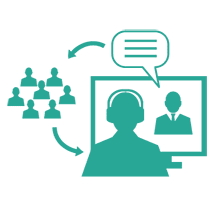
We share certain electronic information through agreements with Federal, foreign, State, local, and private organizations. Our Data Exchange program supports transparency and collaboration. This data typically contains personal information. Agencies disclose the data in accordance with the Privacy Act of 1974 and specific legal authorities, using secure transmission methods to protect the information. We share our information to eliminate manual processes and to reduce the burden on citizens in obtaining benefits across agencies. Data exchanges also reduce improper payments, enhance the administration of our programs and other public programs and support research. This is a supporting tenet of our Vision 2025 priority of operating an innovative organization.
Current and Planned Enhancements
- Prisoner Information for the Do Not Pay Portal: We currently collect prisoner data from over 7,300 correctional facilities using about 2,300 agreements. Through these data exchanges, we prevent improper payments to incarcerated beneficiaries. Section 204 of the Bipartisan Budget Act of 2013 requires us to collect additional information including taxpayer identification numbers, anticipated dates of release, work release dates, and prisoners’ last known addresses. In FY 2017, we will work with the regional prison coordinators on outreach efforts aimed at requesting more prisoner information from institutions as per the legislation.
- Federal Data Exchange Community of Practice: In February 2014, we initiated the first Data Exchange Community of Practice bi-monthly meeting with Federal data exchange partners. We now have over 30 departments or agencies participating. The purpose of the meetings is to collaborate on data exchange activities, share best practices, find common solutions to data exchange challenges, and build a network of Federal data exchange partners. We plan to continue to grow this community of practice during the next several years.
- State Community of Excellence: In addition to the Federal Community of Practice, we also created and plan to grow the State Community of Excellence (CoE). The CoE is an open forum that gives all interested stakeholders an opportunity to share their unique insights on electronic data needs. Through this forum, stakeholders collaborate directly with us and other Federal agencies. The community is an open forum to understand data exchange issues at all levels to transform the way we share and receive data from the states. This inclusive approach helps us develop responsive, effective, and efficient electronic data exchanges to help streamline state health and human services business processes. To learn more, visit our website at State Community of Excellence.
Measurement of Outcomes
We will monitor the growth of the Federal and State communities throughout the next two years. We will also continue to track the progress of prisoner data expansion with correctional institutions.
3. Analytics Center of Excellence (ACE)
Overview
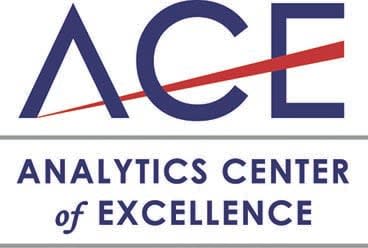
The Analytics Center of Excellence (ACE) is a new component of the Office of the Chief Strategic Officer. This centralized group of highly skilled resources will offer a wide spectrum of data analytics services. ACE will help our agency derive value-added insights from its vast information assets and promote innovation through advanced analytics. ACE supports the open government principle of transparency. These services will drive strategic objectives; increase organizational performance; and improve operational excellence.
ACE seeks to promote a culture of evidence-based policies and decision-making across the agency, instilling transparency into the administration of Social Security programs. To accomplish this, ACE will assist in increasing agency analytics competency. ACE will collaborate with business owners and technology experts to perform insightful analyses of agency data and deliver actionable analytics.
Current and Planned Improvements
The overall objective for ACE is to delve deeper into agency data and obtain valuable insights. Opportunities abound for using data analytics to improve business processes in our agency. Our agency has close to 30 petabytes of data. Mining available data will provide significant, new opportunities for our agency to improve operational management, organizational performance, and oversight of its programs.
We developed a formal analytics training program through our agency’s Gerald Ray Academy (GRA). This program now operates in concert with ACE. The GRA trains staff on techniques to conduct sophisticated data analytics. The GRA also presents techniques to develop, analyze, and use data analytics to support agency policy development and business decision-making processes. GRA will also provide practical experience on analytical techniques.
The GRA has delivered in-depth training sessions throughout the agency, graduating ten GRA fellows. The GRA fellows conducted research studies on disability policy and process through which they discovered possible policy interpretation discrepancies. The fellows also developed a Human Resources Manager’s Tool Kit to provide analytics resources for our managers and employees.
Over the next two years, ACE will:
- Complete the development and implementation of an industry-strength Analytics Maturity Model;
- Use the model to assess agency high-level advanced analytics maturity;
- Participate in formalizing analytics infrastructure and architecture strategy and implementation, including Big Data analytics and tools;
- Progressively identify discrete actions and resources required to bridge the gaps in various components;
- Complete at least three analytics projects each year; and deliver insights to achieve agency priorities and goals;
- Continue and expand advanced analytics training conducted by GRA;
- Establish an internal and external advanced analytics community of interest and practice to enable knowledge sharing; and
- Publish any new data assets created resulting from in-depth analyses to the Enterprise Data Inventory and, if appropriate, to the open government platform.
Measurements of Success
ACE provides tangible results from utilizing evidence and facts to drive policy and decision-making:
- We expect to derive value from the vast stores of our data; and
- Increase evidence-based policy development and decision-making capacity across the organization. ACE will help components increase the maturity of their analytics capabilities and provide relevant and appropriate training via the GRA.
Sustainability
ACE is aligned to support one of the agency's critical priority initiatives - to make data-driven decisions. ACE also supports agency strategic objectives and implementation of Vision 2025.
4. Work Incentives Planning and Assistance Program (WIPA)
Overview

The Work Incentives Planning and Assistance Program (WIPA) projects provide transparency about benefits and services to current disability beneficiaries. The projects use extensive collaboration to deliver a full range of direct and indirect services to disability beneficiaries who are working, about to work, or are serious about employment. The WIPA projects are grants awarded by us and, along with other programs, provide support to disability beneficiaries for returning to work.
Beneficiaries with disabilities often access an intricate system of services that assist them to meet daily financial and physical needs. Beneficiaries sometimes fear losing supports if they start to work. In addition, confusion engendered by the complexity of these programs may act as a barrier between the beneficiary and self-sufficiency through employment. WIPA projects also collaborate and coordinate services with the full range of Federal, State, and local programs and benefits that exist in the WIPA projects’ service areas. WIPA programs disseminate information about employment, work incentives, and health care to beneficiaries and service providers and offer outreach to underserved populations. The service is free, accessible, and confidential. WIPAs assist beneficiaries to anticipate changes, to find resources to continue working, and to make appropriate reports. WIPAs also help beneficiaries build financial stability and to successfully meet or exceed employment goals.
WIPA projects provide accurate, clear, and comprehensive information and support. WIPAs help beneficiaries navigate the complex programs and work incentives that provide a cushion for the beneficiary as he or she reenters the job market. WIPA projects assist beneficiaries to understand their earnings, the effect of earnings on benefits and health care, and when, how, and what to report. WIPA services will help working beneficiaries avoid overpayments, incorrect payments, and underpayments.
Public Engagement
WIPA programs provide direct counseling about work incentives and benefits, and serve as a liaison to employment service providers and link beneficiaries to other services. These services include services offered by State vocational rehabilitation programs, Employment Networks (agencies providing rehabilitation services authorized under Section 1148 of the Ticket to Work and Work Incentives Improvement Act), America’s Job Center services, and Protection and Advocacy for Beneficiaries of Social Security.
WIPA projects engage in outreach. WIPA outreach serves to inform local service providers about WIPA services and Social Security’s efforts to support work activity. WIPA projects serve as clearinghouses for accurate, timely, and appropriate information for beneficiaries. WIPA projects also provide referrals to other resources in the communities they serve, and as an ongoing comprehensive support to beneficiaries while on the road to employment.
Measures of Improvement
Success for beneficiaries does not simply mean getting a job. Many work attempts fail because of benefit or service changes that beneficiaries do not anticipate or understand. For example, a beneficiary could stop working when they receive an overpayment letter, lose a housing subsidy, or lose other supports due to increased income. To prevent such an occurrence, WIPA projects provide support from the point a beneficiary seriously considers work until the point the beneficiary no longer needs or desires the assistance.
We will continue to track the outcomes for all beneficiaries receiving WIPA services. We expect these beneficiaries to have a more positive return to work experiences, and a better understanding of benefits and services.
Sustainability and Outcomes
We awarded 83 new WIPA grants in July 2015 for a five-year performance period. Awardees submit continuation applications annually that include an analysis of eight benchmarks. Benchmarks are standardized measures of accomplishments. Grantees, using a national database that we provide, report on certain measures of service to beneficiaries. These measures include the time from which a beneficiary enrolls in WIPA services to follow-up services. We track the number of follow-up services over a designated timeframe and provide beneficiaries with a full benefits summary and analysis report. These examples are just a few of the items tracked and measured in our program. Beneficiaries come to understand how work affects their cash and health benefits. We encourage beneficiaries to seek employment to secure a more financially secure future and an independent life in their community. Remaining on benefits ensures a life of poverty while employment opens up a world of possibilities.
5. Health Information Technology (IT)
Health IT reduces the time to obtain the medical records needed to support disability determinations and helps us manage that information more efficiently. Health IT supports our Vision 2025 priority to operate as an innovative organization. Using Health IT provides:
- A fully automated request and receipt process for medical evidence;
- Complete and standards-based medical records; and
- Faster disability decisions using extensive rules-based decision support.
We began this initiative based on input from and collaboration with:
- Medical associations;
- Health privacy advocates;
- Medical providers; and
- State and Federal agencies such as the VA and Department of Defense (DoD).
We proved, in a live production setting, that we can obtain and process medical records faster using health IT. Health IT fully automates the process for obtaining medical evidence. The time it takes us to complete a disability claim decreases as the number of treating sources using health IT increases. As of July 2016, we had partnerships with various medical networks and providers in 49 States and the District of Columbia, Guam, and Puerto Rico. These included 7,569 health IT providers within 54 organizations.
In February 2016, we completed a national rollout with the DoD on the eHealth Exchange. The eHealth Exchange is a community of partners who share health information under a common trust framework and a common set of rules. We were the first participant when eHealth Exchange (formerly known as NwHIN) began operating in 2009. As of March 2016, the eHealth Exchange had more than 110 participants sharing health data for more than 100 million patients. Participants include four Federal agencies, about 50 percent of our country’s hospitals, 26,000 medical groups, 3,400 dialysis centers, and 8,300 pharmacies.
We plan to continue our outreach efforts in FY 2016, 2017, and 2018, to include additional medical providers and VA. We will also expand connections on the eHealth Exchange. We will collaborate with the Office of the National Coordinator’s Federal Health Architecture Boards. We will also participate on government-wide health IT policy and standards setting advisory panels, workgroups and task forces. These efforts bring together Federal, State, and private sector organizations to meet our common goal of the interoperability of health records. We participate in these committees to ensure that Social Security’s business needs and requirements are included in national standards and policies.
Each year, we make about three million initial disability claim determinations. In FY 2016, we expect that more than eight percent of initial claims will contain health IT medical evidence. We expect the volume and percentage of initial disability cases with health IT to increase as we continue outreach efforts and expand our partnerships.
For additional information, visit our agency's Health IT Internet site.
In March 2016, the second annual Federal Health IT Innovation Awards, sponsored by FedHealthIT and G2Xchange Health, were announced. Our Agency was the winner of the Digital Engagement Category for our development and launch of Customer Engagement Tools.
Conclusion
We are in the process of implementing a long-term strategy, Vision 2025, to help prepare our agency for success in the years ahead. As we developed this strategy, we asked questions such as, “How should Social Security operate differently in the next 10-15 years to accomplish our mission?” and “How might a changing operational environment affect Social Security’s ability to deliver services effectively and efficiently in the future?” Work on implementing our long-term strategy is vital, as it will allow us to anticipate and address challenges, and positions us to take advantage of new opportunities. We look forward to taking advantage of these new opportunities in the coming years by using the tools and techniques associated with open government. Specifically, we will continue to:
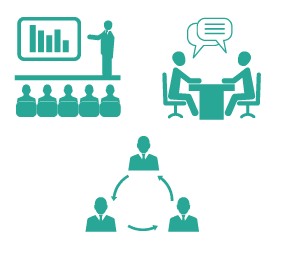
- Increase Transparency by sharing and being accountable for information that is of genuine interest and value to the public;
- Foster Participation by offering a various channels for multiple audiences to engage with us and provide ideas on how we can improve our programs and services; and
- Enhance Collaboration by working with other agencies and organizations to exchange ideas for improving our service to the public.
Appendix A: Federal Open Government Initiatives
Data.gov
We support open data. We will continue to add datasets to Data.gov so that the public has access to agency data that is important to them in their personal and business endeavors. Social Security's public data listing in machine-readable format is also available online.
Analytics.usa.gov
We participate in the Digital Analytics Program (DAP) by using its federated code. DAP allows us to provide metrics to analytics.usa.gov, and the government-wide account that is part of the Google Analytics (GA) administrative web site. Both allow us and other agencies to see one another’s popularity and metrics. With our newly combined domains (socialsecurity.gov and ssa.gov), analytics.usa.gov usually shows us as one of the top ten most popular websites. Within the GA administrative interface, one can see all the participating agencies. The “SSA Profile” is where a user drills down for our agency's Profile or View for further information. Our Agency and the General Services Administration continue to use an “anonymizer” to help protect an agreed upon level of personally identifiable information. We also participate in the periodic DAP office hour conference calls for sharing of information, questions, and general experiences relating to the program.
eRulemaking
We are a partner agency in the eRulemaking initiative known as the Federal Docket Management System (FDMS), publicly accessible at the Government Regulations page. Staff members from our Office of Regulations actively serve on several committees in the ongoing development and modifications to FDMS and the public-facing website at regulations.gov.
Information Technology Dashboard
On an annual basis, we develop the Agency Information Technology (IT) Investment Portfolio Summary; i.e. "Exhibit 53." It includes prior year actual amounts; current year budget authority estimates; and budget year plans and requests. We submit our Agency IT Investment Portfolio Summary (Exhibit 53) to OMB and the Federal Information Technology Dashboard (ITDB). Our submittal ensures that our agency meets the Clinger-Cohen Act and Federal Information Technology Acquisition Reform Act requirements to provide a full and accurate accounting of IT investments.
Once the annual submission is complete, we provide monthly progress updates on the major IT investment to the ITDB. These updates include actual cost and schedule information, and updates to contract information. The updates also include performance metrics, project risks, operational risks, Integrated Project Team contacts, and any changes to projects and activities. Periodically, the Chief Information Officer rates each investment based on our pre-established criteria, and posts this assessment with appropriate comments, to the ITDB.
DATA Act
The Digital Accountability and Transparency Act (DATA Act) requires agencies to report more financial information to USAspending.gov in 2017. Upon implementation in May 2017, the DATA Act will make federal-spending data more accessible, searchable, and reliable. We will submit spending data to USAspending.gov in accordance with the Federal Spending Transparency Data Standards established by OMB and The Department of the Treasury on August 31, 2015. As part of the FY 2017 budget submission, we submitted our DATA Act implementation plan to OMB on September 14, 2015. The implementation plan included project milestones, concerns, budget estimates, and a timeline. Treasury also maintains a GitHub page for Federal spending transparency.
Externally, the data submitted for DATA Act reporting will be a continuation of the reporting for The Federal Funding Accountability and Transparency Act (FFATA). The DATA Act requires a more detailed level of reporting that will provide users of the data with a higher level of transparency.
Internally, we prepare management reports on budgetary resources, obligations, and outlays. Some of the reports include obligation balances by object class. Upon implementation, we will be able to reuse the data to prepare these reports or provide management the tools to prepare their own reports.
Catalog of Federal Domestic Assistance - CFDA.gov
We maintain full descriptions for the public about our grant programs on the Catalog of Federal Domestic Assistance website. Whenever there are major changes to existing programs or we add new programs to our portfolio, we submit this information to the site. Potential grantees can use this site to find out the objectives, proper uses, and eligibility requirements for our programs.
USAspending.gov
The FFATA requires information on Federal awards be made available to the public via a single, searchable website. Therefore, OMB established the USAspending.gov website. We use USAspending.gov to post details regarding our, contracts, grant activity, and benefit payments. This information improves transparency and provides the public information regarding how we are using the resources entrusted to our agency. Our benefit payments include obligations from the Old Age and Survivors Insurance and Disability Insurance trust funds, Supplemental Security Income and Special Veterans Benefits programs.
Contract Data
OMB requires us to provide contract data to the Federal Procurement Data System Next Generation (FPDS-NG), which posts the data to USAspending.gov. FPDS-NG also requires us to provide a data file containing program source data (that is, Treasury Account) directly to USAspending.gov. We provide the data file via the USAspending Data Submission and Validation Tool (DSVT) until USAspending can accept program source data from FPDS-NG.
Federal Financial Assistance
OMB M-09-19 requires us to submit grant and assistance payments data using the Federal Assistance Award Data System (FAADS) PLUS format. Federal financial assistance includes grants and assistance payments made under Federal domestic assistance programs listed in the Catalog of Federal Domestic Assistance.
- Financial Assistance Awards – Grants: Our grants management system, GrantSolutions, has FAADS PLUS data compilation and formatting capabilities, and we submit our grants data to USAspending.gov via DSVT.
- Financial Assistance Payments - Mandatory and Entitlement Programs: OMB Memorandum M-09-19 requires us to report data about our benefit payments to USAspending. We report these data to USAspending.gov in the FAADS PLUS format via the USAspending Award Submission Portal.
Open Procurement and Vendor Outreach
In accordance with the guidance contained in the Office of Federal Procurement Policy's February 2, 2011 memorandum on addressing misconceptions to improve communication with the industry during the acquisition process, we developed and published a formal Vendor Communication Plan. This plan discusses the steps we will take to enhance outreach to our industry partners and reduce unnecessary barriers to competition in the procurement process.
Additionally, we created a centralized repository that allows interested vendors to submit capability statements and other marketing information to our agency. The repository facilitates exchanges with industry and promotes internal market research efforts. This tool is a searchable database that will help agency personnel to identify qualified sources of supply and services. The tool also promotes exchanges of important procurement information with industry. Read our vendor information repository guidance.
Declassification Program
The Open Government Directive requires agencies to publish links to information about their declassification programs. We do not have original classification authority. We cannot classify any document or system of record. Therefore, we do not have a declassification program.
Access to Scientific Data and Publications
Our research organizations conduct and sponsor research on a wide range of topics relating to Social Security programs and policy, disability, retirement, income security and poverty. Our researchers have expertise in the social sciences, Social Security programs and Social Security program data. Some research has an inward focus on program policy formulation, implementation and evaluation. Other research has an outward focus, looking at Social Security programs, applicants and beneficiaries in the broader context of public policy, disability policy and income security.
We often publish our research in the agency's quarterly research journal, the Social Security Bulletin. Other research publication vehicles include research and statistics notes, issue papers, policy briefs and working papers. We do not publish some research such as internal program and policy evaluation, analysis of process improvements and support for the Trustees Working Group.
Historically, our research budget falls below the $100 million threshold established by the Office of Science and Technology Policy. In FY 2016, we exceeded the threshold due to a one-time investment in the Early Intervention Demonstration initiative. However, we anticipate that the research budget will again be below the $100 million threshold in future fiscal years. Early intervention measures, such as supportive employment services for individuals with mental impairments, have the potential to achieve long-term gains in the employment and the quality of life for people with disabilities. The demonstration projects provide medical and vocational services prior to individuals receiving benefits. We can test whether these services help individuals with these impairments remain active in the workforce. We can test to see whether these services help avoid or delay a need for disability benefits.
Open Source Software
We are reviewing and adjusting, as necessary, our policies and practices dealing with three aspects of open source:
- Contractual agreements with third-party vendors;
- Promoting the use of open source code; and
- The process for sharing our code as open source with the public and other Federal agencies.
Appendix B: Whistleblower Protection
In August 2013, we published a Whistleblower Protection Ombudsman (WPO) webpage to serve as an educational tool for our employees about whistleblower protections. The page includes contact information for the Office of the Inspector General’s WPO, background information on whistleblower protection and answers to commonly asked questions.
We completed all agency actions required for the U.S. Office of Special Counsel’s (OSC) Title 5 of the United States Code section 2302(c) Certification Program. In May 2016, we received our compliance certification from OSC.
Appendix C: Addressing Societal and Scientific Challenges through Citizen Science and Crowdsourcing
The September 30, 2015 memorandum from the Director of the Office of Science and Technology provided guidance for Federal use of crowdsourcing. In response, we updated our Open Government webpage to include a broader array of crowdsourcing and participation opportunities open to members of the public. We offer online ideation forums to gather public input to use in the policy-making process. We also solicit customer feedback on our open data offerings and public input to improve agency plans. Finally, we provide links for the public to comment on regulatory matters.
We use crowdsourcing in a wide range of ongoing activities, including:
- Developing agency strategic plans;
- Developing program policy;
- Building adjudication tools for internal use; and
- Updating our Open Government Plan.
The following highlights some areas in which we use crowdsourcing.
Participation and Crowdsourcing in Support of Policy Development and Evaluation
We use crowdsourcing techniques to develop the agendas for our National Disability Forum, which meets about every four months. We use public facing venues such as online ideation tools, bulletins, and surveys before meetings to promote stakeholder discussion of the specific issue in upcoming forums. We post minutes from each meeting to our National Disability Forum website. Participants are able to continue providing input using this tool for two to four-weeks following the meeting.
We also use crowdsourcing techniques in support of research and policy evaluation. We use standard scientific and participation methods, much like those approaches presented in the Citizen Science and Crowdsourcing Toolkit.
Each year, we crowdsource ideas for research and policy evaluation and make selections based on that input. After development of the project, the grant awardee presents the research to peers and for public comment before finalizing the work. One particular research effort is titled, "Does Eliminating the Earnings Test Increase the Incidence of Low Income among Older Women?" This research was conducted by the Michigan Retirement Research Center at the University of Michigan. We funded this project through a grant and it is an example of this type of public policy evaluation. This research serves as valuable information for retirement policymakers. The project looked at the effect of the elimination of the Retirement Earnings Test, as enacted in the Senior Citizens' Freedom to Work Act of 2000. The research analyzed Social Security data combined with public data from other sources. This effort highlights the use of open data and using public data for developing and evaluating public policy. We use this process as part of our efforts to develop young scholars while getting the benefits of the knowledge of a wide range of individuals. We will continue this work in 2016 and beyond.